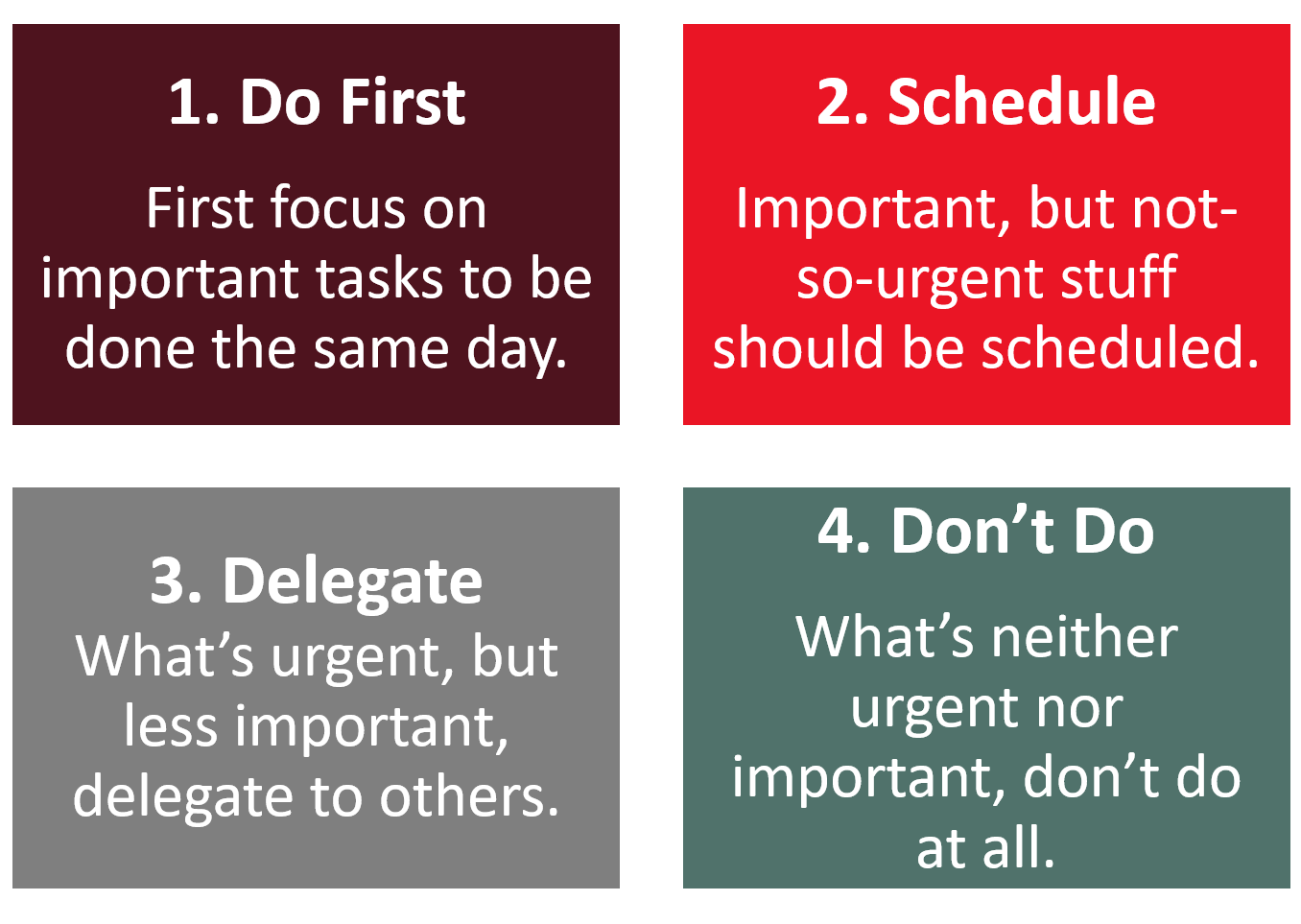26 Procrastination and Improving your Productivity
Procrastination
Procrastination can restrict your potential and undermine your success. Many perfectionists procrastinate, they fear that they cannot complete the task perfectly and resist beginning or completing it. Some people believe that they work better under pressure and use this to justify procrastination, but this is just a myth – so don’t fall into that trap.
Here are some strategies that you can use to conquer procrastination:
- Break large or overwhelming tasks into smaller, achievable tasks.
- Reward yourself for tasks that you complete.
- Make yourself accountable to someone else, for example, set up a study buddy system where you and a friend commit to working independently on a task for one or two hours. Peer pressure can work, and it feels less lonely.
- Rephrase your inner dialogue from “I need to” to “I choose to”.
- Minimize distractions.
- It helps to know what motivates you.
– Tackle unpleasant tasks first if it helps to get those out of the way.
– Tackle the easy pieces first if it helps you build momentum. This is where it helps to know what motivates you. - Identify your peak times for work.
– Are you better in the morning?
– Or do you prefer to work later at night? - Set a timer.
- Focus on starting.
This TEDTalk by Tim Urban: Inside the mind of a master procrastinator (2016) offers great insight on procrastination in a humorous way.
Improving Your Productivity
Productivity helps determineing your efficiency. Here are a few ideas to try that are connected to improving your productivity.
The Time Constraint Method
To be more efficient, you need to set deadlines and parameters on your work. The more time you allocate, the less productive you will be. So, consider adding constraints to you work. Set aside 30 minutes or 1 hour to work intensively on a project, instead of planning to work all afternoon.
Prioritizing Your Work
It is easy to feel like every task you are assigned is equally important and valuable. Though they likely do all need to get done, they probably don’t all need to get done right now. You need to reflect on the importance and amount of time the tasks will take when you attempt to prioritize tasks. In truth, your tasks will take different amounts of time, energy, and focus to complete. One of the most important skills you can learn on the job is how to prioritize. Don’t forget to get help when it comes to identifying priorities. Often, your supervisor or instructor will have a better sense of the big picture. They can help you take a list of tasks and turn it into a schedule.
Organize Your Tasks Based on Complexity
To help with your time management, here are a few ways to manage your time based on complexity. These techniques focus on the nature of a task, the level of difficulty, and the
amount of time it requires After you try out these techniques, consider checking in with your boss to make sure your prioritization matches theirs!
The Sequence Method. Sequence your tasks in order of complexity. You might want some sticky notes! First, write down all the different tasks you are assigned in any order. Then, assess each task and arrange them in an order of most important to least important, and most urgent to least urgent. This will help you figure out where to begin and provide you with a clear sequence for your work and where to focus is required.
The Eisenhower Matrix. This technique adds a visual component to the sequence method. Draw a table with four quadrants. Place your tasks onto the quadrant based on their importance and urgency. Tasks that are important are rarely considered urgent whereas those considered urgent are may not be important tasks. This method will help you to understand to understand which tasks you must do, schedule, delegate, or eliminate. See below for an example of a visual representation of this matrix.

In this matrix, allocate the most amount of time to the important but not-urgent tasks because they are directly associated with your productivity. The absence of a deadline but the requirement of their completion indicates the weight these tasks carry in relation to your work.
Divide and Conquer Your Tasks
Another way to maximize your efficiency is to know how to group, organize, and divide your tasks. The techniques in this section are based on the idea of enhancing your productivity through maximizing your efficiency. Ideally, you should focus on one task or a set of similar tasks. Doing this is more rewarding than constantly having to switch between different tasks. When you are switching all of the time, you will spend more time reorienting yourself and refocusing.
The Clustering Method. List all of your projects and tasks. Then, cluster those of similar types together. Begin with the most important tasks and get a head start on them. You may also begin with short and urgent tasks to remove them from your list of items that would otherwise hinder progress on more important tasks.
The Energy-Based Method. Assess your overall state, your energy levels throughout the day, and the space and times where you feel most driven and focused. Then, remove as many distractions as possible as they would negatively affect your energy levels. Once you have a good sense of your own patterns, plan your tasks using these patterns. Divide your tasks over the different times, based on your discretion.
Another method that will likely not apply to you in your WIL role, but would be good to know as you progress through your career is the Delegation Method. In this method you divide your tasks into a category of which you would need to complete yourself, tasks that can be delegated to a team, and a set of tasks that can be done automatically.
Stress in Relation to Time Management
Stress is what happens when pressure overwhelms us, and we don’t know how to cope. Though we all deal with stress, some stressors are more than we can handle. Stress is often seen in a negative light, it is described as something that has adverse effects on your health, a harmful feeling if not dealt with. One reality that hasn’t been often included in the descriptions of stress is that it is a natural response. It is your body’s way of telling you that you need to prepare for something, make a change, or face a new challenge. Embracing stress means making a change in your perspective. You need a new outlook where you realize stress is not harmful, but instead indicates you need to do something differently.
In order to properly cope with it and deal with its impacts on our bodies and minds, we need to develop coping strategies. Here are a few:
1. Identify the cause of your stress. Is it work related? Is it stemming from a specific task or deadline? Identifying a cause will help you to work toward a solution, clarify the situation you face and choose a course of action.
2. Visualize all your tasks. Either write them out or look at the list you created. Prioritize tasks. Eliminate all distractions and all unnecessary, non-urgent, and unimportant tasks.
3. Gather your resources. Prepare as your stress informs you. What do you need to do to overcome the stress? Think of all your abilities, your network, and your connections.
4. Devise a plan. Structure your approach, create a mind map or a schedule to help you carry out your plan. Hopefully by this step, you will start to feel your stress levels decrease. Remind yourself that you have chosen to be proactive rather than reactive.
5. Use your support systems. Can you discuss your concerns with your supervisor or a colleague? Can you speak with your supervisor to extend a deadline? Can you request technical supports to aid in the proper completion of a task? A WIL perspective on time management does not solely emphasize your productivity and efficiency in a process, it also intends to prevent the possibility of losing time over incorrect task completions, increase your accuracy in your work, and aid in the development of positive and helpful habits.
Technology and Time Management
We have all spent more than our fair share of time lost down a Wikipedia rabbit hole, stuck in a Netflix binge, or scrolling endlessly on our phones. Technology is often treated in popular culture as a time suck, and, well, it certainly can be. At the same time, many of us will work in fields where we spend lots of time using technology for our jobs. Technology can be a time saver and can help us succeed. Here are a few tips to make the most of your technology to enhance your productivity:
- Embrace the Scheduler. There are so many different apps that can help you with to do list, calendars, etc. Pick just a few and try to set aside time to use them.
- Manage Your Notifications. Turn on notifications that will help with your work but turn off notifications that will encourage you to get distracted.
- Review Your Usage. Many phones now track how much time you spend on them and what you are doing. Take a look at those reports and tweak your behaviour if you are spending too much time scrolling.
- Block Time and Distractions. Schedule time just to work without distraction. This might mean you need to block websites and notifications that keep you out of your work zone.
Getting Help with Time Management
Time management is a life-long skill. Most of us will struggle with aspects of time management throughout our professional lives. Remember, you aren’t alone. Understanding time-management from a WIL perspective requires initiative from you, your supervisor, and your instructor. When you work together to identify priorities and tasks, you will find it much easier to determine when and how to complete the multiple and shifting deadlines you encounter in school and work.
If you need help, get help! Don’t forget that you can access services on campus and in some workplaces to help you with time management needs.
- At Work. Start with your supervisor. They will be able to tell you what is important and why. You may also be able to access support and programs through Human Resources. Many larger organizations provide a free Employee Assistance Program (EAP) which includes access to counselling and support.
- At School. Start with your Professional Skills Coach. Ask them questions and seek out their advice during office hours. You can also check in with your academic advisor, a learning strategist, or Accessibility Services.
- At Home. Turn to your friends and family. Many of them will have faced similar challenges in their own lives. They can help you prioritize, organize, and refocus during times of trouble.
Media Attributions
- “Tim Urban: Inside the mind of a master procrastinator” by Tim Urban is licensed a CC BY-NC-ND licence.
- “Figure 7.1 The Eisenhower Matrix” by Deb Nielsen, Emily Ballantyne, Faatimah Murad and Melissa Fournier is licensed under a CC BY-NC 4.0 licence. Based on Eisenhower, 2021.
References
Cirillo, F. (2021). The pomodoro technique. Cirillio Consulting. https://francescocirillo.com/pages/pomodoro-technique
Einsenhower. (2021). Introducing the Eisenhower matrix. Eisenhower. https://www.eisenhower.me/eisenhower-matrix/
Roomer, J. (2019, 9 Mar). Forget a to-do list, use the ‘ABCDE’ method instead. Medium. https://medium.com/personal-growth-lab/forget-a-to-do-list-use-the-abcde-method-instead-5a3a329ff448
Wen, T. (2020, 21 May). The law that explains why you can’t get anything done. BBC. https://www.bbc.com/worklife/article/20191107-the-law-that-explains-why-you-cant-get-anything-done

